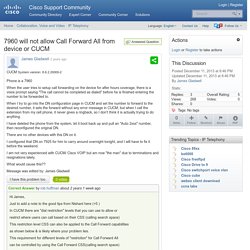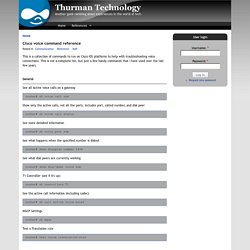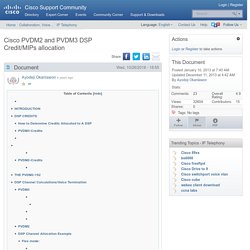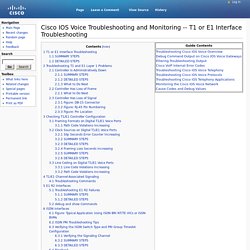

Call Manager 7.0 Shutdown Procedure. 7960 will not allow Call Forward All from device or CUCM. Hi James, Just to add a note to the good tips from Nishant here (+5 ) In CUCM there are "dial restriction" levels that you can use to allow or restrict where users can call based on their CSS (calling search space) This restriction level CSS can also be applied to the Call Forward capabilities as shown below & is likely where your problem lies.

This requirement for different levels of "restriction" for Call Forward All can be controlled by using the Call Forward CSS(calling search space) as detailed below And beautifully explained by one of the very BEST, Hailey from CNC here; Cheers! Rob "When it comes to luck you make your own " - Springsteen. Cisco voice command reference. This is a collection of commands to run on Cisco IOS platforms to help with troubleshooting voice connections.

This is not a complete list, but just a few handy commands that I have used over the last few years. General See all Active voice calls on a gateway router# sh voice call sum Show only the active calls, not all the ports. Router# sh voice call status See more detailed information router# sh voice port sum See what happens when the specified number is dialed router# show dialplan number 1436 See what dial peers are currently working router# show dial-peer voice sum T1 Controller (see if it's up) router# sh controllers T1 See the active call information (including codec)
Cisco PVDM2 and PVDM3 DSP Credit/MIPs allocation. I have over the years heard of cisco dsps using MIPs/credits but I never quite understood how they work.

What I know like many of you is that I can tell how many number of channels a dsp can support based on the PVDM part number. e.g PVDM2-32 can support 32 channels; PVDM3-64 can support 64 channels and so on. In actual fact these computations depends largely on the dsp complexity mode. e.g A PVDM2-32 can support 32 channels or 32 G711 calls, using the default flex dsp mode. If the dsp complexity is changed to high, these values are significantly altered.
Example: A PVDM2-32 that supports 32 channels in flex mode, will only support 16 channels in when the dsp complexity is changed to high. So what is the magic behind all this mathematics? You may want to ask why bother knowing these details when we have the cisco dsp calculator. It’s similar to asking why do you need to know SQL to query/update CUCM database when we already have the CUCM admin page to do that. PVDM3-Credits 1. Dsp 3: 2. Understanding the output of "show voice dsp group all" This document should be used inconjuction with the "Cisco PVDM2 and PVDM3 DSP Credit/MIPS Allocation" to get the best of both.

The link below can be used to access the mentioned doc The show voice dsp group all command is a powerful ios command to view details of dsps on a gateway. This short document attempts to explain the meaning of each of the output of this command. For clarity each output has been numbered. These numbers will be referenced within the document to explain the meaning if the corresponding line. #sh voice dsp group all DSP groups on slot 0: dsp 1: State: UP, firmware: 28.3.3……………………………………………………………………………..1 Max signal/voice channel: 43/43..........................................................................................2 Max credits: 645, Voice credits: 645, Video credits: 0……………………………………..............3 num_of_sig_chnls_allocated: 43…………………………………………………………………….....4 Transcoding channels allocated: 0……………………………………………………………………..5. Cisco IOS Voice Troubleshooting and Monitoring. From DocWiki T1 or E1 Interface Troubleshooting To troubleshoot the T1 or E1 interface, perform the following steps: show controller {t1 | e1} Check if the line is down.

Check for reported alarms. Check for error events. 1. Router# show controller {t1 | e1} controller-number 2. 3. 4. Refer to T1 Alarm Troubleshooting Flowchart, document ID 14174 for a flowchart to troubleshoot error events. 5. Troubleshooting T1 and E1 Layer 1 Problems Most T1 and E1 errors are caused by incorrectly configured lines. Use the show controllers t1 and show controllers e1 commands in privileged EXEC mode to display information about the T1 or E1 links or to display the hardware and software driver information for the controller. Administratively down-If the controller is administratively down, you can manually bring it up using the procedure in the Controller Is Administratively Down section. Solutions for bringing the controller up follow. How many voice calls can be handled by voice gateway PRI. Cleanup and Update Tool for Cisco Unified Communications. Uplinx® Cleanup and Update Tool for Cisco Unified Communications.